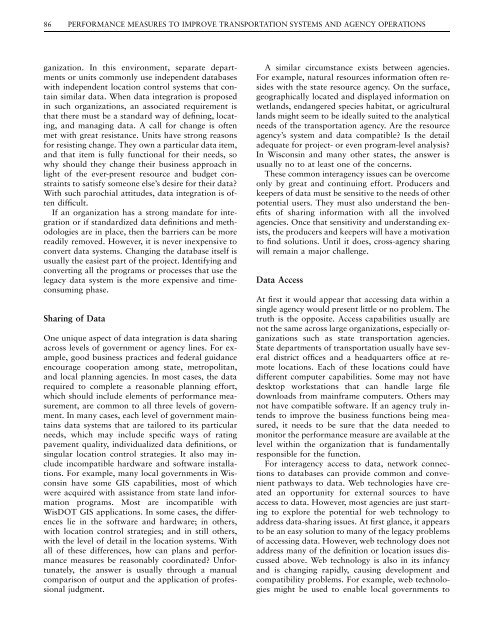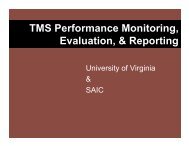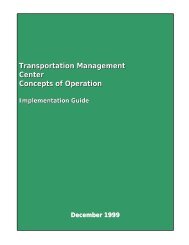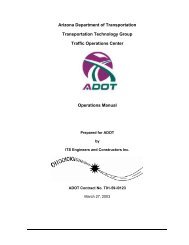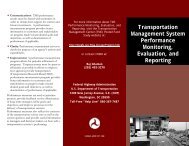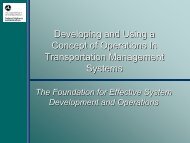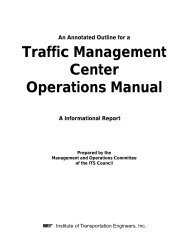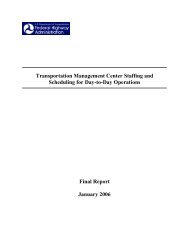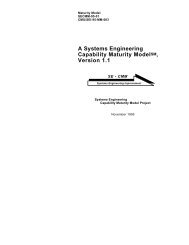Conference Proceedings 26 - Transportation Research Board
Conference Proceedings 26 - Transportation Research Board
Conference Proceedings 26 - Transportation Research Board
- No tags were found...
You also want an ePaper? Increase the reach of your titles
YUMPU automatically turns print PDFs into web optimized ePapers that Google loves.
86 PERFORMANCE MEASURES TO IMPROVE TRANSPORTATION SYSTEMS AND AGENCY OPERATIONSganization. In this environment, separate departmentsor units commonly use independent databaseswith independent location control systems that containsimilar data. When data integration is proposedin such organizations, an associated requirement isthat there must be a standard way of defining, locating,and managing data. A call for change is oftenmet with great resistance. Units have strong reasonsfor resisting change. They own a particular data item,and that item is fully functional for their needs, sowhy should they change their business approach inlight of the ever-present resource and budget constraintsto satisfy someone else’s desire for their data?With such parochial attitudes, data integration is oftendifficult.If an organization has a strong mandate for integrationor if standardized data definitions and methodologiesare in place, then the barriers can be morereadily removed. However, it is never inexpensive toconvert data systems. Changing the database itself isusually the easiest part of the project. Identifying andconverting all the programs or processes that use thelegacy data system is the more expensive and timeconsumingphase.Sharing of DataOne unique aspect of data integration is data sharingacross levels of government or agency lines. For example,good business practices and federal guidanceencourage cooperation among state, metropolitan,and local planning agencies. In most cases, the datarequired to complete a reasonable planning effort,which should include elements of performance measurement,are common to all three levels of government.In many cases, each level of government maintainsdata systems that are tailored to its particularneeds, which may include specific ways of ratingpavement quality, individualized data definitions, orsingular location control strategies. It also may includeincompatible hardware and software installations.For example, many local governments in Wisconsinhave some GIS capabilities, most of whichwere acquired with assistance from state land informationprograms. Most are incompatible withWisDOT GIS applications. In some cases, the differenceslie in the software and hardware; in others,with location control strategies; and in still others,with the level of detail in the location systems. Withall of these differences, how can plans and performancemeasures be reasonably coordinated? Unfortunately,the answer is usually through a manualcomparison of output and the application of professionaljudgment.A similar circumstance exists between agencies.For example, natural resources information often resideswith the state resource agency. On the surface,geographically located and displayed information onwetlands, endangered species habitat, or agriculturallands might seem to be ideally suited to the analyticalneeds of the transportation agency. Are the resourceagency’s system and data compatible? Is the detailadequate for project- or even program-level analysis?In Wisconsin and many other states, the answer isusually no to at least one of the concerns.These common interagency issues can be overcomeonly by great and continuing effort. Producers andkeepers of data must be sensitive to the needs of otherpotential users. They must also understand the benefitsof sharing information with all the involvedagencies. Once that sensitivity and understanding exists,the producers and keepers will have a motivationto find solutions. Until it does, cross-agency sharingwill remain a major challenge.Data AccessAt first it would appear that accessing data within asingle agency would present little or no problem. Thetruth is the opposite. Access capabilities usually arenot the same across large organizations, especially organizationssuch as state transportation agencies.State departments of transportation usually have severaldistrict offices and a headquarters office at remotelocations. Each of these locations could havedifferent computer capabilities. Some may not havedesktop workstations that can handle large filedownloads from mainframe computers. Others maynot have compatible software. If an agency truly intendsto improve the business functions being measured,it needs to be sure that the data needed tomonitor the performance measure are available at thelevel within the organization that is fundamentallyresponsible for the function.For interagency access to data, network connectionsto databases can provide common and convenientpathways to data. Web technologies have createdan opportunity for external sources to haveaccess to data. However, most agencies are just startingto explore the potential for web technology toaddress data-sharing issues. At first glance, it appearsto be an easy solution to many of the legacy problemsof accessing data. However, web technology does notaddress many of the definition or location issues discussedabove. Web technology is also in its infancyand is changing rapidly, causing development andcompatibility problems. For example, web technologiesmight be used to enable local governments to


